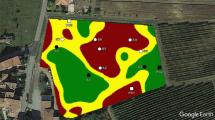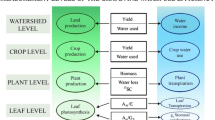Abstract
Spatial variation in yield and fruit composition has been observed in many vineyards, leading to low productivity. In this study, site-specific irrigation was applied in a commercial vineyard (Vitis vinifera L. cv. Shiraz) block in the Sunraysia region of Australia to improve production in low-yielding areas of the block and decrease differences in yield and quality between irrigation management zones. Data collected under uniform irrigation management showed that spatial variation in canopy cover, yield and fruit composition across the vineyard block was substantial. Normalised difference vegetation index (NDVI) and canopy temperature data supported delineation of three irrigation management zones and decisions regarding irrigation strategy. Water use efficiency and yield improvements were achieved by implementing site-specific irrigation. Fruit composition results were varied; pH and titratable acidity showed increased similarity between zones, but other parameters maintained differences between zones. These results lend support to the use of NDVI to determine irrigation management zones.



Similar content being viewed by others
References
Acevedo-Opazo C, Tisseyre B, Guillaume S, Ojeda H (2008) The potential of high spatial resolution information to define within-vineyard zones related to vine water status. Precis Agric 9:285–302
Allen R, Pereira LS, Raes D, Smith M (1998) Crop evapotranspiration. Guidelines for computing crop water requirements. FAO Irrigation and Drainage Paper 56. FAO, Rome, Italy
Arno J, Martínez-Casasnovas JA, Ribes-Dasi M, Rosell JR (2009) Review. Precision viticulture. Research topics, challenges and opportunities in site-specific vineyard management. Span J Agric Res 7(4):779–790
Best S, León L, Claret M (2005) Use of precision viticulture tools to optimize the harvest of high quality grapes. In: Proceedings of FRUITIC 05, information and technology for sustainable fruit and vegetable production, Montpellier, pp 249–257
Bezdek JC (1981) Pattern recognition with fuzzy objective function algorithms. Plenum Press, New York
Bezdek JC, Ehrlich R, Full W (1984) FCM: the Fuzzy c-Means clustering algorithm. Comput Geosci 10:191–203
Boshoff CJ (2010) A study of the interaction between grapevine vigour and water status for Vitis vinifera L. cv Merlot noir in Stellenbosch. Master’s thesis, in partial fulfilment of the requirements for the degree of Master of Agricultural sciences, Stellenbosch University
Bramley RGV (2005) Understanding variability in winegrape production systems 2. Within vineyard variation quality over several vintages. Aust J Grape Wine Res 11:33–42
Bramley RGV, Hamilton RP (2004) Understanding variability in winegrape production systems 1. Within vineyard variation in yield over several vintages. Aust J Grape Wine Res 10:32–45
Bramley R, Pearse B, Chamberlain P (2003) Being profitable precisely: a case study of precision viticulture from Margaret River. The Australian and New Zealand Grapegrower and Winemaker, Annual Technical issue pp 84–87
Fridgen JJ, Kitchen NR, Sudduth KA, Drummond ST, Wiebold WJ, Fraisse CW (2004) Management zone analyst (MZA): software for subfield management zone delineation. Agron J 96:100–108
Goodwin I, McClymont L, Lanyon D, Zerihun A, Hornbuckle J, Gibberd M, Mowat D, Smith D, Barnes M, Correll R, Wheaton A (2009) Managing soil and water to target quality and reduce environmental impact: final report to Grape and Wine Research & Development Corporation Project Number: DPI 04/04. www.gwrdc.com.au/webdata/resources/project/DPI_04-04.pdf. Accessed 13 Dec 2010
Grant OM, Tronina L, Jones HG, Chaves MM (2007) Exploring thermal imaging variables for the detection of stress responses in grapevine under different irrigation regimes. J Exp Bot 58:815–825
Hall A, Louis J, Lamb D (2003) Characterising and mapping vineyard canopy using high-spatial-resolution aerial multispectral images. Comput Geosci 29:813–822
Hall A, Lamb DW, Holzapfel BP, Louis JP (2011) Within-season temporal variation in correlations between vineyard canopy and winegrape composition and yield. Precision Agric 12:103–117
Harbertson JF, Picciotto EA, Adams DO (2003) Measurements of polymeric pigments in grape berry extracts and wines using a protein precipitation assay combined with bisulphite bleaching. Am J Enol Vitic 54:301–306
Iland PG, Ewart A, Sitters J, Markides A, Bruer N (2000) Techniques for chemical analysis and quality monitoring during winemaking. Patrick Iland Promotions, Adelaide
Jackson DI, Lombard PB (1993) Environmental and management practices affecting grape composition and wine quality: a review. Am J Enol Vitic 44:409–430
Lamb DW, Weedon MM, Bramley RGV (2004) Using remote sensing to predict grape phenolics and colour at harvest in a Cabernet Sauvignon vineyard: timing observations against vine phenology and optimising image resolution. Aust J Grape Wine Res 10:46–54
McBratney AB, Moore AW (1985) Application of fuzzy sets to climatic classification. Agric For Meteorol 35:165–185
McClymont L, Goodwin I, Whitfield DM, Green S (2009) The relationship between grapevine sap flow, ETo and effective area of shade. Acta Hort 846:185–192
Möller M, Alchanatis V, Cohen Y, Meron M, Tsipris J, Naor A, Ostrovsky V, Sprintsin M, Cohen S (2007) Use of thermal and visible imagery for estimating crop water status of irrigated grapevine. J Exp Bot 58:827–838
Taylor JA, Acevedo-Opazo C, Ojeda H, Tisseyre B (2010) Identification and significance of sources of spatial variation in grapevine water status. Aust J Grape Wine Res 16:218–226
Trout TJ, Johnson LF, Gartung J (2008) Remote sensing of canopy cover in horticultural crops. HortScience 43:333–337
Williams LE, Ayars JE (2005) Grapevine water use and crop coefficient are linear functions of the shaded area measured beneath the canopy. Agric For Meteorol 132:201–211
Acknowledgments
We wish to acknowledge the Department of Primary Industries Victoria, the Grape and Wine Research and Development Corporation and the Cooperative Research Centre for Irrigation Futures for funding support. We gratefully acknowledge the ongoing commitment of managers of Deakin Estate to allow research to be undertaken at the vineyard. We would particularly like to thank Deakin Estate’s vineyard manager Craig Thornton and irrigation manager Justin McPhee. Finally, we would like to thank Des Whitfield and Mark O’Connell for their contributions and comments regarding this paper and Julie Kirby for technical assistance.
Author information
Authors and Affiliations
Corresponding author
Additional information
Communicated by E. Fereres.
Rights and permissions
About this article
Cite this article
McClymont, L., Goodwin, I., Mazza, M. et al. Effect of site-specific irrigation management on grapevine yield and fruit quality attributes. Irrig Sci 30, 461–470 (2012). https://doi.org/10.1007/s00271-012-0376-7
Received:
Accepted:
Published:
Issue Date:
DOI: https://doi.org/10.1007/s00271-012-0376-7




